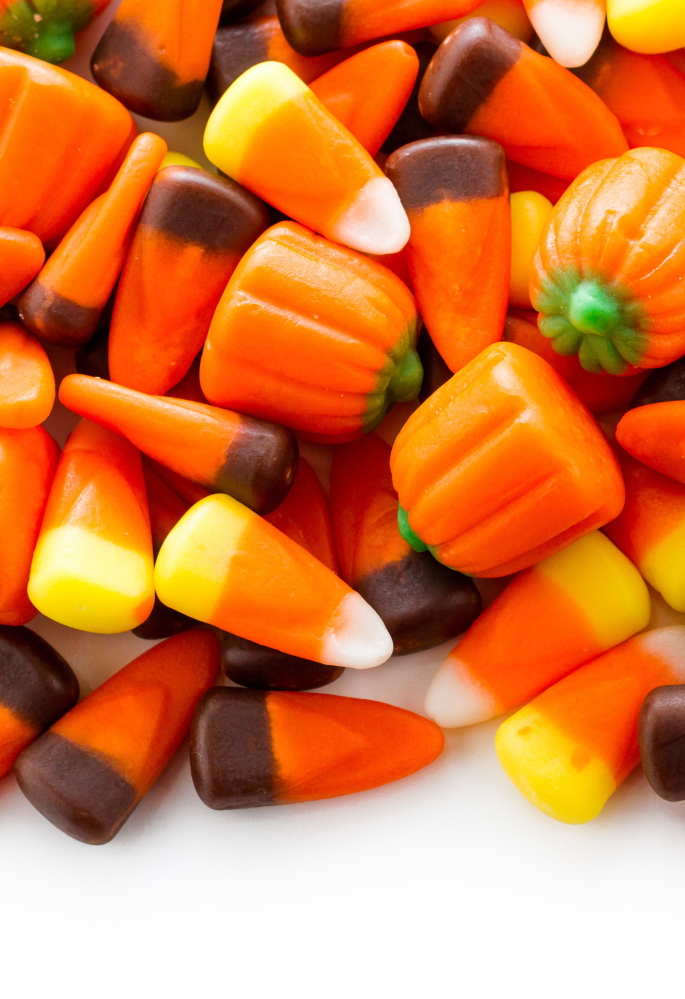What scares me most at this time of year isn’t the prospect of zombies crawling out of Casco Bay or Old Port revelers toilet papering my trees. What I fear most is the day my son discovers Halloween candy.
In his 1-1/2 years on this earth, he’s been sheltered from sugar and protected from food dyes and artificial flavorings. He’s never eaten a Kit Kat or even seen a Gummy Bear. But I realize I can only keep him free of our country’s sugary temptations for so long. Someday he’ll come face-to-face with a Sour Patch Kid.
In hopes that both he and I will be ready when that day comes, I reached out to fellow vegetarian and health-minded parents to find out how they handle this tricky holiday filled with too many treats.
Do they stealthily toss non-vegetarian candies (such as gelatin-laced gummy bears and candy corns) from the trick-or-treat bags, I wondered? Or somehow manage to substitute healthy snacks for candy bars? Maybe they figure it’s just one night, sigh and say, “Go ahead, overindulge.”
The first thing I discovered is that vegetarian parents with toddlers often do what my friend Lindsey Marie Pettus of Cumberland suggests: put off trick-or-treating as long as possible. Her daughter turns 2 this winter.
The next thing I discovered is the existence of a previously unknown-to-me realm of magical creatures – mischievous elves that are a cross of sorts between Santa Claus and the Tooth Fairy.
“I have friends whose kids get visited by the ‘switch witch,'” mom Emily Graham of Portland, told me via Facebook. “She takes most of the candy and leaves a fun toy.”
Mary Ellen Chadd of Green Spark Farm in Cape Elizabeth, mom to twin baby girls, had a similar story from her days as a nanny. “The toothless gnome leaves you money under your pillow for your candy. He has an addiction to sugar!”
Then I caught up with Maggie Knowles of Portland, whose 61/2-year-old son intends to go trick-or-treating for the first time this year. She has a similar strategy planned.
As the co-founder of healthy vegan snack company Kids Gone Raw, Knowles is handing out the company’s mini Monster Mash Rawkin’ Rolls, made from bananas, strawberries and spinach, at her door. But she knows her son will bring home a bag full of commercially dyed and flavored sugar.
“We’ll go through everything, and he can have five pieces,” Knowles said, and added that the only thing she’ll draw the line at is candy made with gelatin, which is created by boiling animal bones, connective tissue and skin. “The rest will go to the troops.”
Knowles is referring to Operation Gratitude, a California-based nonprofit that sends care packages to U.S. military members and at this time of year works with dentists and orthodontists to collect candy from local kids.
Her husband, Dr. Bruce Podhouser of Orthodontic Associates in Scarborough, participates in the program by buying candy from patients and other trick-or-treaters for $1 per pound for up to five pounds of candy. Last year, his office collected and donated more than 100 pounds of candy.
This year, the office will buy back candy Nov. 3 and 4 from 9 a.m. to 5 p.m.
Knowles doesn’t anticipate that her son will have trouble sticking to the five-piece limit, saying “I’ve been telling him all along that you don’t get to keep all that candy. It’s the lifestyle we live in our house. He knows that sugar is bad for him.”
This sort of advance preparation is key to steering kids toward moderation on Halloween or any other night, according to Bob Gentry of Boothbay, whose family is transitioning from vegetarian to vegan eating.
“My philosophy as a single parent is that I want to give my kids background information instead of saying ‘you can and can’t do this,'” said Gentry, who has daughters ages 13, 11 and 9. His two youngest plan to go trick-or-treating.
Gentry says they talk a lot about the obesity epidemic and its causes and have an ongoing discussion “about food dyes and the poor quality of food on store shelves.” As a result, when “they see all that candy they say, ‘Maybe a piece or two,'” Gentry tells me.
His daughters’ moderation is helped by the fact they know how to read food labels, and they can tell Halloween treats are filled with questionable ingredients.
Gentry said any candy with artificial food colorings or partially hydrogenated oils is automatically set aside in a pile along with candies the girls don’t like. Gentry takes these candies to his office. However, this still leaves his children with a pile of candy – mostly chocolate. Next, he offers to buy some of the remaining candy for $5.
“Trader Joe’s sells a good compromise candy bar,” Gentry said. “I tell them, ‘Cash in all this garbage and you can get $5 and use it at Trader Joe’s.’ It gives them the power to decide. Maybe they want a new necklace or a pair of earrings, instead. It’s up to them.”
Knowles and Gentry’s approach to parenting strives to give kids full information about the world around them and then allows them to make their own choices, and sometimes mistakes.
“I’m educating and involving them in the process, but allowing them something sweet,” Gentry said. “Ultimately what it amounts to is I strive to make them partners in the battle, not opponents. One little piece of candy is not the battle.”
I’m aiming to adopt a similar attitude on that not-too-distant day when my son gets his first look at Halloween candy. I just hope I won’t be too frightened when it happens.
Avery Yale Kamila is a freelance food writer who lives in Portland. She can be reached at:
avery.kamila@gmail.com
Twitter: AveryYaleKamila
Send questions/comments to the editors.



